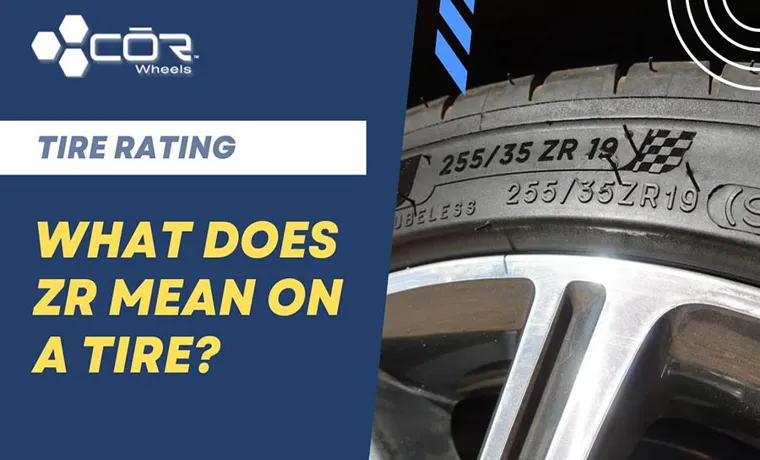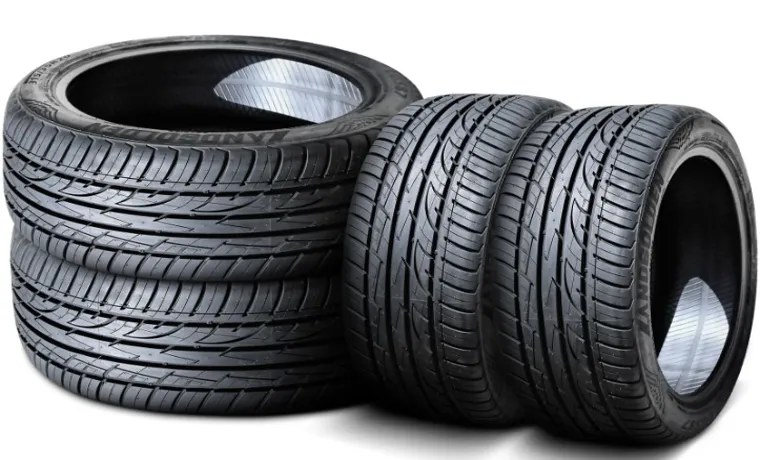Have you ever looked at the sidewall of your tires and noticed the letters “ZR” printed on them? If you’re curious as to what this means, you’re not alone. Many drivers are confused about the significance of these two letters on their tires. In this blog, we’ll demystify the meaning of “ZR” and explain why it’s important for you to understand this component of your tire’s labeling.
Whether you’re a professional mechanic or a new driver, knowing what this abbreviation means will help you make informed decisions about your vehicle’s performance and safety. So, let’s get started and learn more about what “ZR” signifies on your tires.
Table of Contents
Understanding Tire Markings
If you’ve ever come across a tire with the markings “ZR” or “Z” on its sidewall, you might be wondering what they actually mean. Well, the “Z” or “ZR” on a tire indicates that it’s rated for high speeds, specifically above 149 mph (240 km/h) for “ZR” and above 149 mph for “Z”. This speed rating is typically found on performance or sporty tires, and it’s important to note that it’s not safe to drive a tire at speeds beyond its rating.
So, if you’re planning to drive your car at high speeds, it’s crucial to ensure that you have the appropriate speed-rated tires installed. Additionally, you should always ensure that your tires are properly inflated and in good condition to prevent any potential blowouts that could occur when driving at high speeds. So, if you see the markings “ZR” or “Z” on your tires, you know that they’re designed to withstand high-speed driving, but always be sure to drive responsibly and safely.
Tire Type and Width
When it comes to tire markings, it can be overwhelming to understand what all those symbols and numbers mean. However, it’s important to understand tire type and width for safety and performance reasons. The most common tire markings include the tire type, which is typically represented by a letter such as P for passenger car or LT for light truck.
Additionally, the tire width is represented in millimeters and is the measurement from sidewall to sidewall. This number can vary widely depending on the type of vehicle and the desired performance characteristics. Generally, a wider tire offers better grip and handling but may sacrifice fuel efficiency, while a narrower tire may be more fuel-efficient but won’t provide the same level of handling.
Understanding tire markings is essential for choosing the right tires for your vehicle and ensuring optimal performance and safety on the road.

Aspect Ratio and Construction
Understanding tire markings is crucial in selecting the right tire for your vehicle. One of the important aspects to consider is the tire’s aspect ratio, which is expressed as a percentage that represents the height of the tire’s sidewall compared to its width. For example, a tire with a 70 aspect ratio means that its sidewall height is 70% of its width.
A lower aspect ratio tire tends to have a shorter sidewall and may offer better handling and stability, while a higher aspect ratio tire often provides a more comfortable ride. Another important aspect to consider is the tire’s construction, which can influence its performance in various road conditions. There are two types of tire constructions, bias-ply, and radial.
Bias-ply tires tend to be more durable for heavy loads and rough terrain, while radial tires offer better handling and fuel efficiency. It’s important to keep in mind that choosing the right tire for your vehicle goes beyond just looking at the aspect ratio and construction. Other factors such as tread pattern, tire size, and load capacity should also be considered.
So, it’s always a good idea to consult with a tire professional before making a purchase to ensure that you get the right tire for your needs. In summary, understanding tire markings and their significance can help you make an informed decision on the best tire for your vehicle’s performance and safety.
Rim Diameter and Load Index
Rim Diameter and Load Index play a crucial role in understanding tire markings. Rim diameter is the measurement of the distance from one end of the rim to the other, and it is usually given in inches. Load Index refers to the maximum load capacity that a tire can bear.
The Load Index can be found on the sidewall of the tire and is represented by a numerical value. The higher the number, the more weight a tire can carry. It’s important to note that not all tire markings are the same.
Manufacturers use various codes and symbols to convey important information about the tire, including its size, construction type, and speed rating. Understanding these markings can help you choose the right tire for your vehicle and ensure maximum performance and safety on the road. For instance, if you’re driving a heavy-duty truck, you need a tire with a high load index and a large rim diameter.
Similarly, if you’re driving in areas with high rainfall, you may need a tire with a better grip and tread pattern. Therefore, it’s crucial to pay attention to the markings on your tire and match them to the specific needs of your vehicle. In conclusion, Rim Diameter and Load Index are important aspects to consider when choosing a tire.
They indicate the tire’s size and load capacity, enabling you to find the right tire for your vehicle. Understanding tire markings is a critical factor in ensuring a safer and smoother driving experience.
Speed Rating and ZR Rating
When it comes to buying new tires, you might have noticed a bunch of markings on the sidewalls. These markings contain important information about the tire’s size, type, and performance specifications. Two of the most critical markings to pay attention to are the speed rating and ZR rating.
The speed rating signifies the maximum safe speed that the tire can handle without failing or losing traction. The rating typically ranges from Q (99 mph) to Y (186 mph) but can vary depending on the tire construction and intended use. The ZR rating is a variation of the speed rating used for ultra-high-performance tires.
It indicates that the tire is rated for speeds above 149 mph and meets specific performance standards. So if you’re driving a sports car or a high-performance vehicle, make sure to choose a tire with a ZR rating to ensure optimal safety and handling on the road.
Decoding the ZR Rating
Have you ever wondered what the series of letters and numbers on your tire meant? Specifically, what does the “ZR” rating signify? The “ZR” rating is commonly found on high-performance tires and represents the tire’s maximum speed rating. The letter “Z” indicates a speed rating of over 149 mph, while the “R” denotes that the tire has radial construction. This means that the tire’s cords run perpendicular to the tread, providing excellent stability and handling at high speeds.
It’s essential to note that tires with a higher speed rating may not necessarily improve your vehicle’s overall performance. Instead, they allow for safer and more reliable handling during high-speed driving. So next time you’re in the market for new tires, consider the “ZR” rating as an indicator of a high-performance tire capable of handling high speeds with precision and stability.
What ZR Stands For
If you are a car enthusiast, you might have come across the term “ZR” rating when shopping for tires. ZR stands for “Z” speed rating and “R” construction type. The Z speed rating designates that the tire can safely handle speeds above 149 mph.
However, not all ZR-rated tires have the same exact speed rating as they are gradually increased for every letter. For example, a tire with a ZR rating might have a speed rating of W (168 mph) or Y (186 mph). Additionally, the R construction type means that the tire has radial ply construction, making it more durable and resistant to wear and tear.
Overall, the ZR rating is a designation given to high-performance tires designed for sports cars and other vehicles that require high-speed handling and stability. So, if you are in the market for tires for your sports car, make sure to consider ZR-rated options to ensure that your car can handle the demands of high-speed driving safely.
Benefits of ZR Rated Tires
When it comes to tires, the ZR rating can play a big role in determining their performance capabilities. The “Z” in the rating stands for “Z-speed rating,” and indicates that the tire is capable of reaching speeds of 149 mph or higher. Additionally, the “R” stands for “radial construction,” which refers to the way the tire is made.
ZR rated tires are typically made with advanced materials and technologies, allowing them to provide superior handling, traction, and overall performance at high speeds. They can also offer increased durability and a longer lifespan than lower-rated tires. If you frequently drive at high speeds or want to get the most out of your vehicle’s performance, upgrading to ZR rated tires can be a worthwhile investment.
Conclusion
In conclusion, the enigmatic letters “ZR” on a tire may leave some scratching their heads, but fear not! ZR actually stands for “zero radial,” indicating that the tire has a shorter sidewall and stiffer construction for improved handling at high speeds. So, the next time you see ZR on a tire, you can rest assured knowing that you have a badass, performance-focused tire ready to grip the road. Now go forth and unleash your inner speed demon!”
FAQs
What does “ZR” mean on a tire?
“ZR” stands for “Z-speed rating” and indicates that the tire is rated for speeds of 149+ mph.
Are ZR-rated tires necessary for everyday driving?
No, ZR-rated tires are typically designed for high-performance vehicles and are not necessary for everyday driving.
Can ZR-rated tires be used in all seasons?
It depends on the specific tire, but many ZR-rated tires are designed for summer use only and may not perform well in winter conditions.
How do ZR-rated tires compare to other speed ratings?
ZR-rated tires are the highest speed rating available and generally provide better handling and performance at high speeds than lower-rated tires.
Do all brands of tires offer ZR-rated options?
No, not all brands of tires offer ZR-rated options. It’s important to check with the manufacturer to see if they offer a ZR-rated tire.
Are ZR-rated tires more expensive than other tires?
Yes, ZR-rated tires are often more expensive than lower-rated tires due to their high-performance capabilities.
Can ZR-rated tires be used on any vehicle?
No, ZR-rated tires are often only recommended for use on high-performance vehicles and may not be compatible with all vehicles. It’s important to check with the manufacturer for compatibility.



